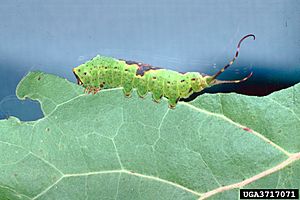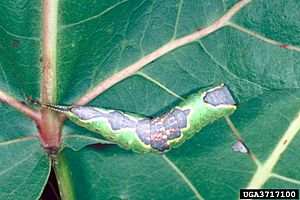Gray furcula moth facts for kids
Quick facts for kids Gray furcula moth |
|
|---|---|
 |
|
 |
|
| Scientific classification | |
| Synonyms | |
|
The gray furcula moth, also known by its scientific name Furcula cinerea, is a type of moth. It belongs to a family of moths called Notodontidae. This moth was first officially described by a scientist named Francis Walker in 1865.
You can find the gray furcula moth in many parts of North America. It lives across the United States, in southern Canada, and even in the Northwest Territories.
Contents
About the Gray Furcula Moth
What Does It Look Like?
The gray furcula moth is a medium-sized moth. Its wingspan usually measures between 33 and 45 millimeters. That's about the length of two standard paper clips!
Its front wings are mostly light gray. They have areas of medium gray in the middle and near the edges. The back wings are a lighter grayish-white color. You might also spot a dark spot in the center and a line of black dots along the edge.
Life Cycle and Habits
Adult gray furcula moths are active during warmer months. In the southern parts of their habitat, you can see them flying from April to September. Further north, they are usually active from May to August.
In the south, these moths can have two generations of offspring each year. This means they complete their life cycle twice. However, in the colder northern regions, they usually only have one generation per year.
What Do Gray Furcula Moths Eat?
The young moths, called larvae or caterpillars, love to munch on leaves. They mostly feed on the leaves of trees like birch, poplar, and willow species.
You can find these caterpillars from spring through fall in the south. In the north, they are typically seen from July to August. When winter comes, the moth spends this cold time as a pupa. This is a resting stage before it transforms into an adult moth.

